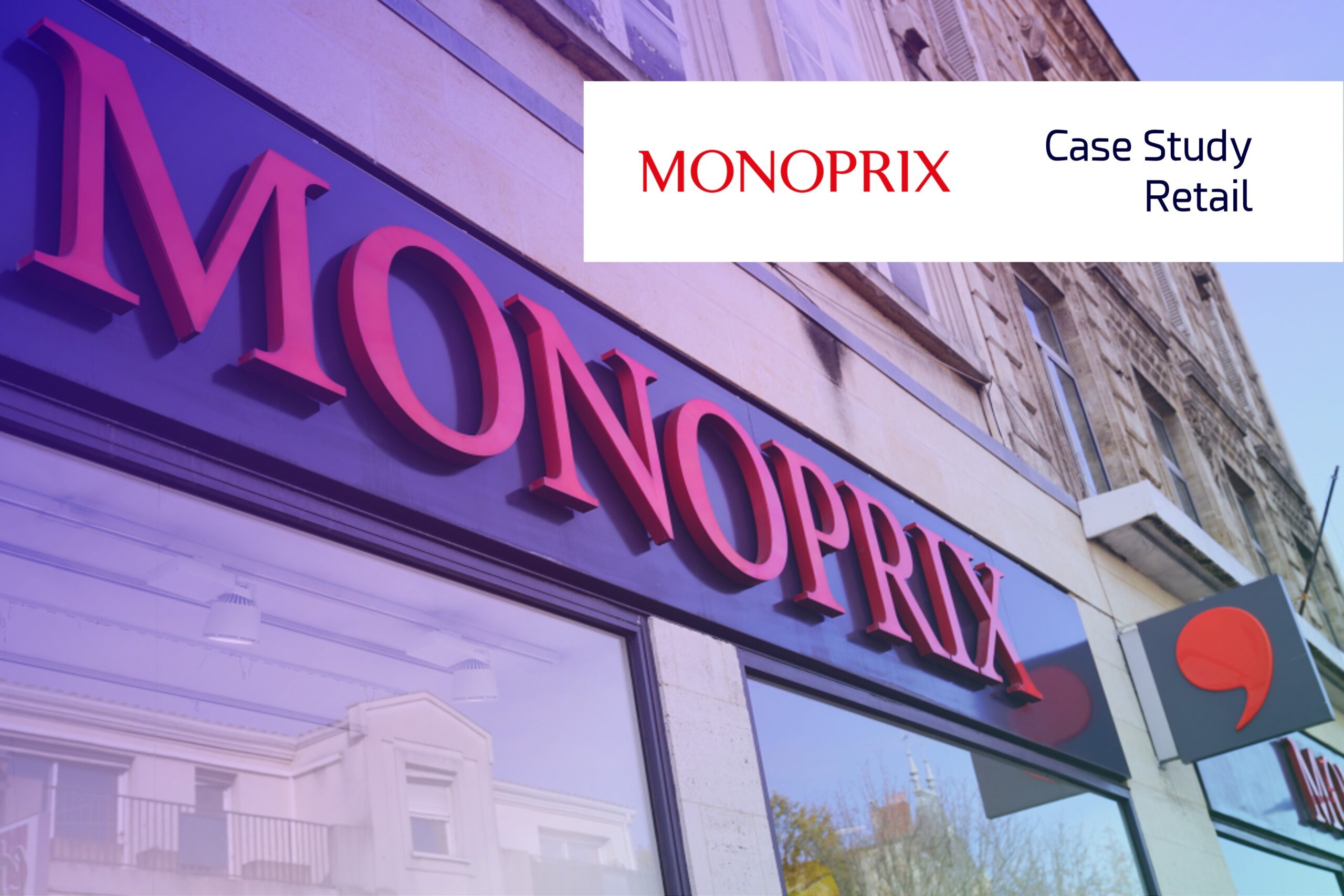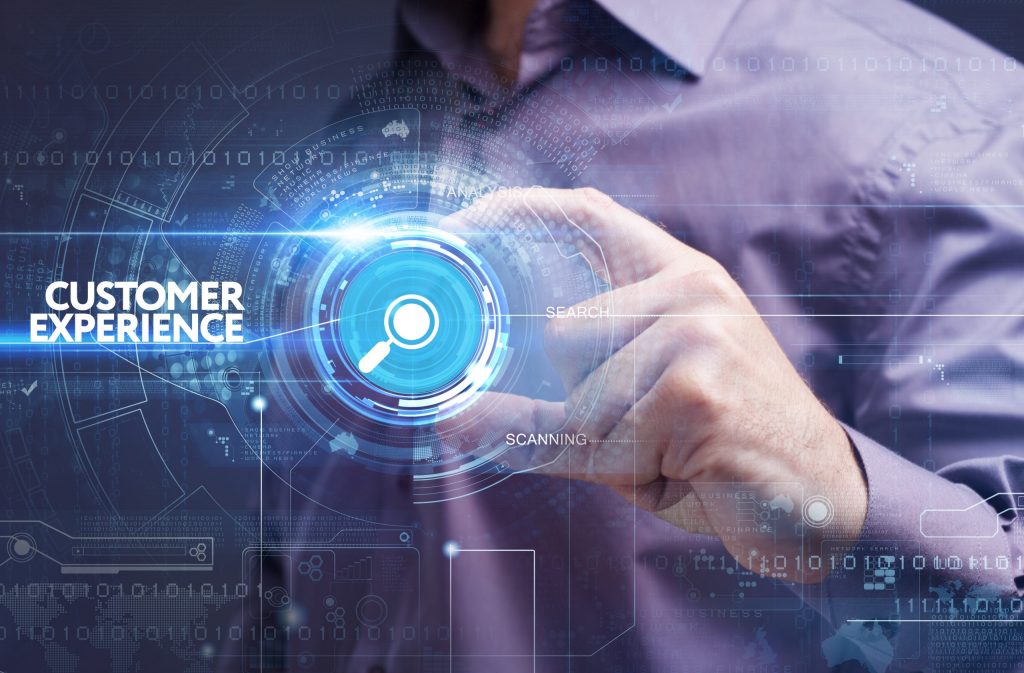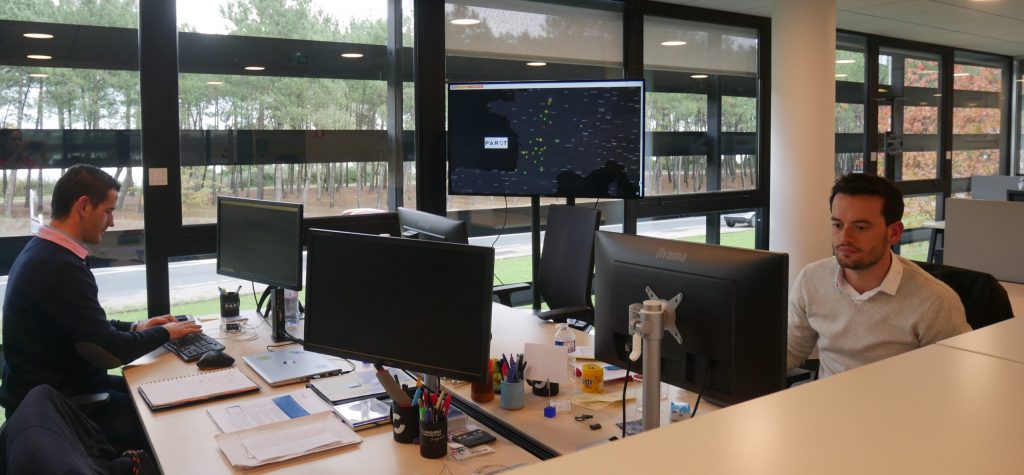“Our monitoring scope is extensive, with 17,000 devices in 725 stores and over 130,000 services, we can’t afford to lose sight of any of these elements. Without Centreon, we’d really be in the dark and operating operating effectively would be very challenging. Centreon monitoring has become an important, if not critical, part of our IT organization and performance, especially to ensure a zero-defect customer experience”.
Laurent Lelong – Infrastructure and Network Manager – Monoprix IT Department
The project in a nutshell: Monitor 725 stores in France and guarantee an optimal customer experience
Strategic objectives: Deliver a flawless customer experience in a highly competitive environment
- Ensure adequate checkout times
- Ensure IT availability in all of France’s 725 stores
- Provide customers with a seamless digital experience
IT objectives: IT availability and efficiency across 725 stores
- Anticipate outages before they impact the customer experience
- Ensure the right capabilities to monitor an SD-WAN architecture and the critical applications that provide services to customers (electronic scales, electronic labels, home delivery).
The solution: Centreon Business Edition
Key Benefits: Seamless Visibility from a Single Console
- A single console to manage all monitoring data
- Ability to manage large volumes of data and a large monitoring perimeter
- Seamless visibility across 725 points of sale
- Greater reliability and efficiency in monitoring
- Simple integration between Centreon and the rest of the IT stack
- Relevant and customized alert management through integration with an SMS messaging system
- More proactive incident detection
- Synthetic visual dashboards for 100+ IT users
Summary
Monoprix is among France’s leading city-center retail stores, across generations. Since the opening of its first store in Rouen in 1932, Monoprix always stayed true to its business model: making the good and the beautiful accessible to all. The company generates sales of 5 billion euros (including franchises) and welcomes 800,000 customers every day in 861 stores, including 725 in France (Monoprix, Monop’, Naturalia, Monoprix Maison, both company-owned and franchised) and 136 worldwide – as well as on its e-commerce site monoprix.fr.
Within Monoprix’s IT department, Laurent Lelong, Infrastructure and Network Department Manager, has the heavy responsibility of ensuring IT availability and efficiency for the 725 stores under his guard, as he puts it:“We have to guarantee an optimal customer experience in a competitive business where every stage of the customer journey is critical. That’s why we need to monitor firewalls as well as applications that manage cash registers, electronic labels and scales, paperless receipts or even home delivery.”
To meet new market expectations, IT teams must ensure that IT systems always remain available and efficient. In the retail sector, it’s not so much availability as the speed and performance of the IT that are now a major monitoring challenge, as Laurent explains: “What has really changed in recent years is the criticality of IT. It used to be about finding out what worked (or didn’t), whereas now it’s more about anticipation. We have to be much more proactive. We have to be able to call the store before the problem is even noticeable. There’s a real culture of immediacy. We have to be more responsive because IT has a direct impact on the customer experience….
Beyond the challenge of responsiveness, the other issue is visibility. The scope to be monitored is particularly important, ranging from local servers to applications in the cloud, as Laurent explains: “We have to monitor the local IT that connect our stores, the firewalls with SDWan, the electronic banking system, or even applications directly linked to the customer, such as manual or automatic checkout software, or customer loyalty and home delivery applications.”
Centreon was implemented in 2017 to replace a solution that could no longer meet the full scope of needs, and which could not manage the increasing criticality of IT in the business.
The Centreon solution quickly demonstrated its value and the monitoring scope was widely expanded, covering almost all IT layers, cloud and non-cloud:“We cover an extensive monitoring scope : 17,000 hosts across 725 locations, with more than 130,000 services to date.”
Currently, nearly 100 users from the IT department use Centreon on a daily basis, accessing dashboards organized by application domain. Views are available by domain or by application. The data is accessible to all for transparency and is presented in highly visual dashboards with a color scheme that highlights incidents. From these views, any user can drill down into the details to learn more and easily identify the causes of potential problems or malfunctions.
“The full IT ecosystem is constantly being monitored. It’s very important for us to have a complete and exhaustive view of sites, applications and equipment, and avoid monitoring tools multiplication. We collect and aggregate data from different sources (firewalls, applications, etc.) and of different types, such as the number of transactions, which we then need to summarize so it’s easy to comprehend.”
At Monoprix, the most critical IT performance areas are databases, network access, electronic payment performance, and customer loyalty applications.
The IT team is able to monitor indicators relating to average transaction times at the checkout, as well as each stage in the dispatch of paperless sales receipts to ensure they get to customers.
Centreon and its central monitoring console are becoming more and more indispensable every day. A fact which Laurent summarizes: “We can’t afford to be blind. Without Centreon, we would really be in the dark and operating effectively would be very challenging. Centreon monitoring has become an important, if not critical part of our IT organization and our ability to deliver a zero-defect customer experience.”
The full story
Monoprix, one of France’s beloved retail chains, is committed to providing customers with a zero-defect experience, an experience that relies heavily on the availability and efficiency of its IT. Electronic labels, paperless sales receipts, home delivery – many customer services are monitored by the Centreon monitoring solution, which provides a complete and detailed view from a single console, including indicators and alerts tailored to the needs of an optimal customer experience.
MONOPRIX: “Bringing the good and the beautiful to everyone, in the heart of the city”
Monoprix is one of France’s leading city-center convenience stores, and a favorite across generations. Since the opening of its first store in Rouen in 1932, Monoprix has never changed its recipe: to make beauty and goodness accessible to all and to be the first to popularize the latest trends.. Its positioning cultivates differentiation in all areas: food, beauty, fashion, and home. The company generates sales of 5 billion euros (including franchises) and employs 21,000 people. Every day, it welcomes 800,000 customers in 861 stores – 725 in France (Monoprix, Monop’, Naturalia, Monoprix Maison, both company-owned and franchised) and 136 worldwide – as well as on its e-commerce site monoprix.fr.
With the evolution of retail, such as omnichannel and phygital (the blending of digital and physical stores), the brand needed to evolve monitoring practices for extended visibility across the digital value chain to ensure IT availability and performance.
Strategic objectives: Ensuring a 0-defect customer experience throughout the entire shopping experience
Within Monoprix’s IT department, Laurent Lelong, Infrastructure and Network Manager, has the weighty responsibility of ensuring IT availability and efficiency for the 725 stores and e-commerce sites he oversees:
“We have to guarantee an optimal customer experience in a competitive business sector where every stage of the customer journey is critical, and where we have to monitor firewalls as well as applications that manage cash registers, electronic labels and scales, paperless receipts, and home deliveries.”
Digital transformation has accelerated the role of IT during the health crisis, with a direct impact on infrastructure hybridization and on how IT is managed, which called for an adapted and unique monitoring tool to centralize data and accelerate responsiveness.
ITOM objectives: Beyond availability, ensuring the performance of cloud and non-cloud IT across 725 sites
To meet these new market challenges, teams must ensure the constant availability and performance of IT assets. In the retail sector, it’s not so much IT availability as IT speed and performance that are now the main challenges for monitoring, as Laurent explains:
“What has really changed in recent years is the criticality of IT. It used to be about finding out what was working (or not), now it’s more about anticipating. We have to be much more proactive. We have to notify the store before the problem is even visible. There’s a real culture of immediacy. We must enhance responsiveness because IT directly impacts customer experience.
Beyond the challenge of responsiveness, the other issue is visibility. The scope to be monitored is particularly important, ranging from local servers to applications in the cloud, as Laurent explains: “We have to monitor our stores’ local IT, the firewalls with SDWan, the electronic payment system, or even customer-facing applications, such as manual or automatic checkout software, customer loyalty and home delivery applications.”
The project: Deploying a monitoring solution that’s tailored to business-critical IT
Centreon was deployed in 2017 to replace a solution that was no longer adapted to the company’s needs and the increasing criticality of IT in the retail sector. The team first questionned the parent company on their monitoring practices:
“The Casino Group was already monitoring warehouses with Centreonwith much satisfaction. We learned from their experience and then called on Centreon’s professional services teams to help us with the implementation.
The Centreon solution quickly demonstrated its value and the scope was extended, covering almost all IT layers, cloud and non-cloud: “We use Centreon to monitor the operator routers, the firewalls that carry the SD-WAN, ESX, all the store VMs (commercial animations, electronic labels, scales, manual and automatic cash registers, PCs, delivery applications, wifi standards, etc.), Kubernetes services, hardware, the electronic payment system and paperless receipts, cloud services, the company’s social network, and more.”
“Our monitoring scope is extensive : 17,000 hosts (ranging all monitored devices) on 725 sites with more than 130,000 services to date.”
Although the IT team still considers their monitoring approach to be predominantly technical, they use checks and indicators that directly contribute to the customer in-store experience, to IT reliability, and the team’s efficiency.
Result: Total, centralised visibility of IT performance, from electronic scales to electronic payments
Nearly 100 users in the IT department currently use the Centreon solution on a daily basis, accessing dashboards organised by application domain. Views are available by domain or by application. The data is accessible to all in the interests of transparency and is presented in highly visual summary views with a colour scheme to highlight any malfunctions. From these views, any user can drill down into the details to learn more and easily identify the causes of potential problems or malfunctions.
“The entire system is constantly monitored. It’s very important for us to have a complete and exhaustive view of sites, applications and equipment, and to limit the number of consoles. We collect and aggregate data from different sources (firewall, applications, etc.) and of different types, such as the number of transactions, which we have to summarise to make it easier to read.”
Advanced integration within Centreon for greater efficiency and reliability
The solution’s two administrators leverage Centreon’s monitoring connectors and automation capabilities to gain efficiency in the deployment and discovery of hybrid cloud and non-cloud devices to monitor. This is how the team can discover new cash registers and automatically configure their monitoring, retrieving the data from the MDM (Mobile Device Management) solution. When new devices are detected, their data is fed back and integrated directly into Centreon.
“We have a centralized monitoring system allowing us to monitor the company social network, as well as VDIs (virtual desktops) hosted on Google Cloud, Microsoft Azure microservices, and Kubernetes PODs. We also monitor emails sent to customers and to delivery service partners, through Microsoft Azure.”
Another strength of the Centreon platform is its openness. Laurent appreciates its ability to provide seamless connections and integrations with, among others, AKS Azure, GKE GCP, Fortinet and the TC 56 terminals that support orders on the Monoprix application. In particular, he uses the capabilities that allow alerts to be built directly on the firewall via APIs and scripted in Python.
“SMS alerts are a real plus for us. We’ve linked Centreon to the Orange SMS tool, which allows us to better manage our on-call times and automate the sending of SMS”.
New indicators and critical alerts for a zero-defect customer experience
At Monoprix, the most critical IT performance areas are databases, network access, electronic payment performance, and customer loyalty applications.
“If customers have to wait a long time for the transaction to be confirmed after they’ve entered their credit card code, the checkout queue gets longer, and the customer experience suffers. So we’ve introduced a new indicator based on a threshold rather than system availability. It sends an alert if the payment time exceeds 30 seconds, so we can check whether the problem is with us or with our partner Ingenico.
Centreon can be used to monitor indicators relating to average transaction times at checkout, as well as to check each stage in the dispatch of paperless receipts to ensure that they reach the customer. The IT team wants to focus more on these types of metrics to ensure the best possible customer experience, a very important part of the company’s culture. Centreon and its centralized console are becoming indispensable. Laurent sums it up this way:
“We can’t afford to be blind. Without Centreon, we would really be in the dark and operating effectively would be very challenging. Centreon monitoring has become an important, if not critical part of our IT organization and our ability to deliver a zero-defect customer experience.”
Pro tip
“In a competitive industry where every step of the customer journey is critical, we must ensure an optimal customer experience. That’s what makes it so crucial to monitor as many devices and applications as possible within a single platform, and provide alerts based on system behavior. We monitor firewalls as well as applications for managing cash registers, electronic labels and scales, paperless tickets, or even home delivery, and we have set up alerts for payment slowdowns, for example.
To go further
- Peer Insights ebook “Monitoring Anything, Anywhere.”! Discover how Centreon can help you achieve the triple aim of operational excellence. Download our Peer Insights ebook to learn how nine industry leaders are achieving their uptime, efficiency, and performance goals.
- Other companies operating in industry or logistics rely on Centreon to guarantee digital performace. Read these customer stories to learn more: monitoring with Centreon, Gerflor, a reputed French manufacturing multinational and global leader known for its resilient flooring and wallcovering solutions, enjoys total IT visibility over 47 international sites, automotive industry leader ZF Group paves the way for the future of its digital transformation with an innovative IT Monitoring Platform, Amer Sports, a global player in sports equipment, reinforces the management of its digital value chain through centralizing infrastructure monitoring for 20 IT-critical locations, FM Logistic relies on Centreon for constant IT availability and managing digital challenges in the supply chain
- Meet the challenges of IT and OT convergence to connect the physical and digital worlds. Check out our ebook “Bridging the physical and digital worlds”, where we help IT Operations teams navigate convergence challenges and share expert tips for achieving smooth visibility and efficiency! Download our ebook.
- If you’re looking to acquire new IT monitoring capabilities, our peer-informed procurement guide “Aligning IT monitoring capabilities & budget using TCO” will help you to select the IT monitoring solution you need. Download the expert insight.
- SaaS or Self-Hosted Monitoring? If you’d like to conduct a careful TCO assessment, don’t go it alone — read our latest expert content “IT monitoring and TCO: SaaS or self-hosted?” You’ll find some insights as well as a complete list of potential hidden costs to consider, so you can choose a monitoring solution which meets both your expectation and budget.
- Looking to run a deeper analysis to decide between open source or paid IT monitoring? Download the first Expert Insight volume, “IT Monitoring & TCO: Open source or off-the-shelf software? Finding the best option for your organization,” which looks at an IT monitoring solution type’s impact on the TCO, helping you opt for one that is perfectly adapted to your organization.
- Visit our resource center: ebooks, guides, reports, success stories, tutorials, and more to help you in your IT monitoring 🙂
- Join the Centreon community on The Watch.
- Contact us for a personalized demo and ask our monitoring experts any questions you may have.
- To keep informed about Centreon news or events, subscribe to our monthly newsletter.








